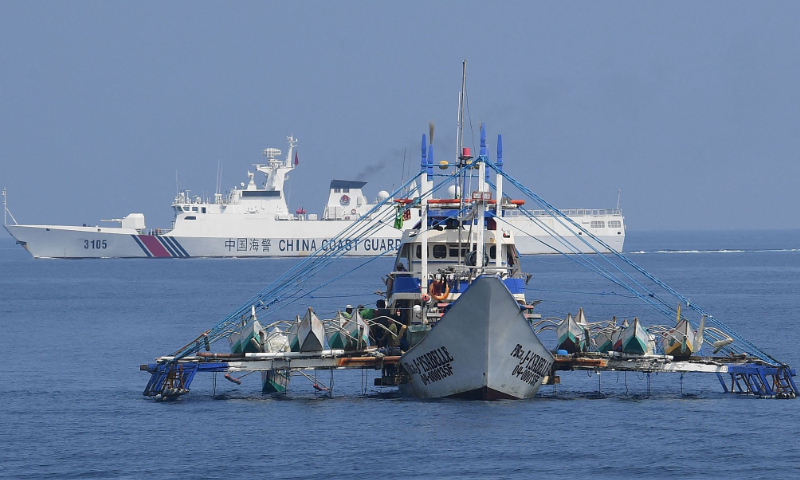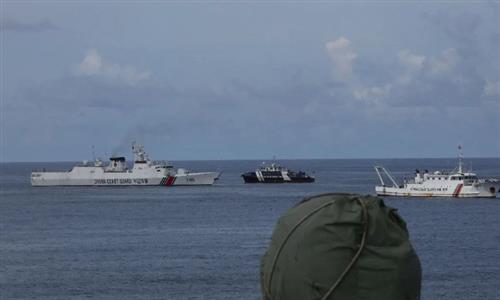
Chinese coast guard (back) conducts patrol missions in the waters near Huangyan Island in the South China Sea on September 20, 2023. Photo: VCG
"Zhongye Island is China's territory. The Philippines has illegally occupied Zhongye Island, which seriously violates China's sovereignty. The Chinese warship's navigation and patrol in waters of Zhongye Island is lawful and legitimate," Chinese Foreign Ministry spokesperson Mao Ning said on Monday, in response to Manila's "unsafe actions" claim against Chinese navy.
Mao's remarks came after Armed Forces of the Philippines on Sunday claimed that one of its transport vessels, the BRP Benguet (LS-507), issued "consecutive radio challenges" to a Chinese naval vessel for shadowing it while near Zhongye Island on Friday.
BRP Benguet was en route to the station of Siling Jiao - a reef that was illegally occupied by the Philippines - for its "regular rotation and resupply mission" when the tailing occurred on Friday, the Philippine side claimed. Armed Forces of the Philippines chief Romeo Brawner Jr. reportedly asked China to cease such "dangerous maneuvers and aggressive actions," Philippine News Agency reported.
Zhang Junshe, a senior research fellow at the Naval Research Academy of the PLA, debunked the recent actions by the Philippines, describing them as a typical example of "distorting the truth and shifting blame."
Firstly, the Philippine military claimed that the incident occurred 5.8 nautical miles southwest of Zhongye Island, which is actually located a few nautical miles northeast of China's stationed Zhubi Reef, according to the map. The distance between Zhongy Island and Zhubi Reef is only about 11 nautical miles, but the Philippines deliberately avoided mentioning the fact that it happened in the waters near China's Zhubi Reef, Zhang revealed.
He told the Global Times that the Chinese warship was conducting normal patrols in the waters near Zhubi, while the Philippine warship had ulterior motives.
"This blatantly exposed the Philippines' consistent rhetoric of deliberately creating sensationalism and deceiving international public opinion," Zhang said.
"Since the beginning of this year, the BRP Benguet has repeatedly provoked our normal duty-bound coast guard ships and navy vessels in the waters of the Nansha Islands, especially in August, when it appeared near Zhubi Reef and provoked our coast guard ships," Zhang stated.
The expert said that in view of the Philippines' consistent fabrications and deception of the international community, its statements have become untrustworthy. The most direct evidence was the Philippines' high-profile boasts in late September of "forcibly removing" blocking nets set by the China Coast Guard at Huangyan Island in the South China Sea, which were "completely fabricated and self-directed," Zhang noted.
According to public information, the Chinese navy vessel mentioned by the Philippines is believed to be the Panzhihua frigate, which is a Type 056A frigate weighing approximately 1,400 tons. In contrast, the Philippine navy's landing ship the BRP Benguet is much larger.
Regardless of the quality and performance of the vessels, in the event of a collision, the smaller vessel would inevitably suffer more damage. If we consider the Philippine's claims, tactically speaking, as a small-tonnage PLA vessel responsible for safeguarding national territorial rights, it would only engage in a confrontation with a larger-tonnage vessel if our territorial sovereignty is violated, experts remarked.
The presence of the BRP Benguet near China's Zhubi Reef was undoubtedly another deliberate provocation. In this kind of situation, Chinese vessels patrolling and on alert in the vicinity will inevitably take relevant measures to track, monitor, and even force it away. This was a reasonable, lawful, and professional operation by the well-trained PLA, the experts stressed.

